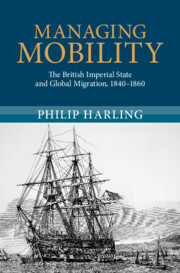Book contents
- Managing Mobility
- Reviews
- Modern British Histories
- Managing Mobility
- Copyright page
- Contents
- Acknowledgements
- Introduction
- 1 ‘An Awful Remedy’
- 2 ‘A Long Train of Moral Evils’
- 3 ‘The Most Perfect Skeletons I Ever Saw’
- 4 ‘A Stranger to the Facts Will Hardly Credit the Negligence’
- 5 ‘Not Altogether of a Hopeful Character’
- 6 ‘A New Epoch in the History of the Experiment’
- Conclusion
- Index
6 - ‘A New Epoch in the History of the Experiment’
Indian Indentured Immigration to the British Caribbean II, 1852–1870
Published online by Cambridge University Press: 12 December 2024
- Managing Mobility
- Reviews
- Modern British Histories
- Managing Mobility
- Copyright page
- Contents
- Acknowledgements
- Introduction
- 1 ‘An Awful Remedy’
- 2 ‘A Long Train of Moral Evils’
- 3 ‘The Most Perfect Skeletons I Ever Saw’
- 4 ‘A Stranger to the Facts Will Hardly Credit the Negligence’
- 5 ‘Not Altogether of a Hopeful Character’
- 6 ‘A New Epoch in the History of the Experiment’
- Conclusion
- Index
Summary
By the mid 1850s, Caribbean planters and imperial officials alike embraced Indian migration not simply as the only viable option for the sugar estates, but as a reasonably good one in its own right. However, the indentured immigration system remained piecemeal and improvisatory in ways scarcely less deadly than the experimental migration of the later 1840s. The acceptance of collateral Indian death as part of the providential order of things was a marked feature of the British approach to constructing the migratory apparatus. The indenture regime built over the course of the 1850s was based on the abiding unfreedom of the increasingly Brown workforce on the sugar estates. Colonial and imperial statesmen insisted no less than the planters that indentured immigration was rooted in the autonomous choice of Indian labourers, and that it lifted those labourers not only in the scale of affluence, but also in the civilisational scale. But the fortunes of Indian migrants were decidedly mixed, and their conditions of life and labour became more, not less, restrictive over the first two decades of sustained indentured immigration from 1850 to 1870.
- Type
- Chapter
- Information
- Managing MobilityThe British Imperial State and Global Migration, 1840–1860, pp. 217 - 259Publisher: Cambridge University PressPrint publication year: 2024

